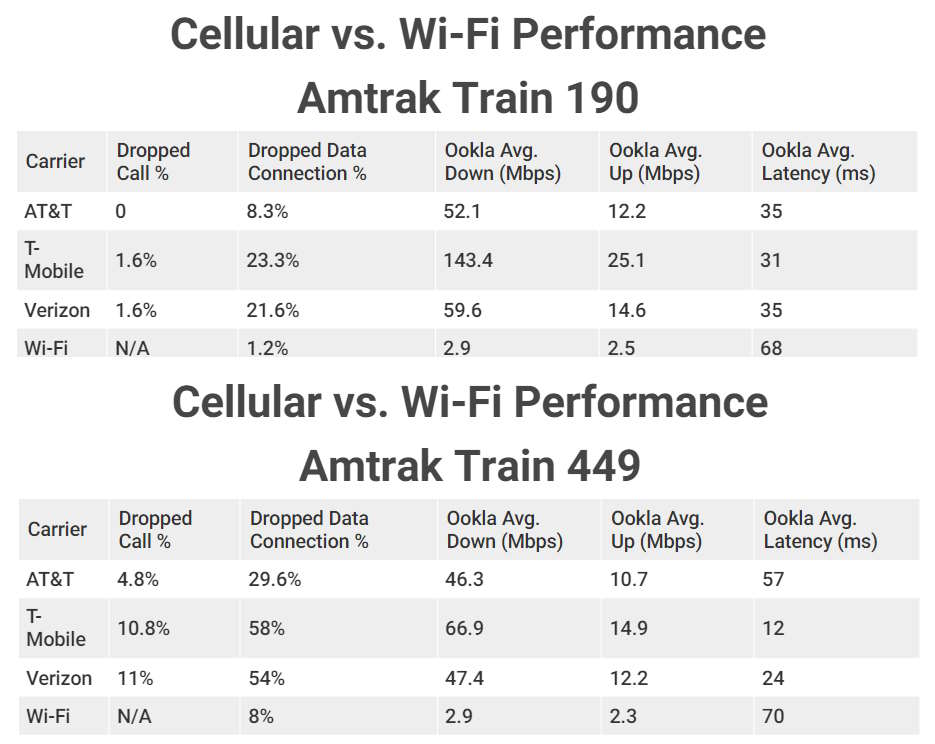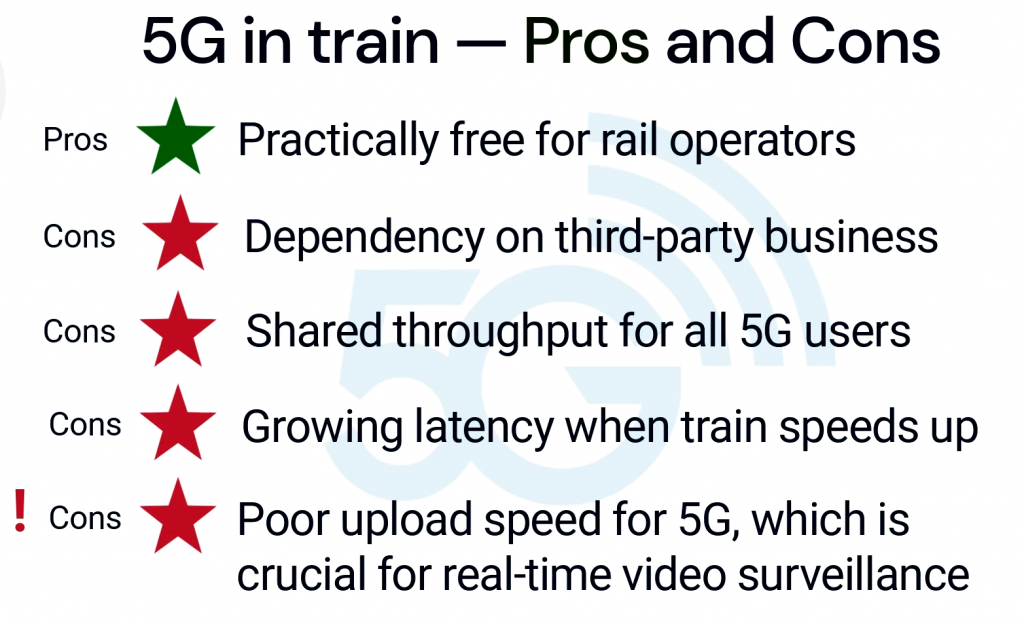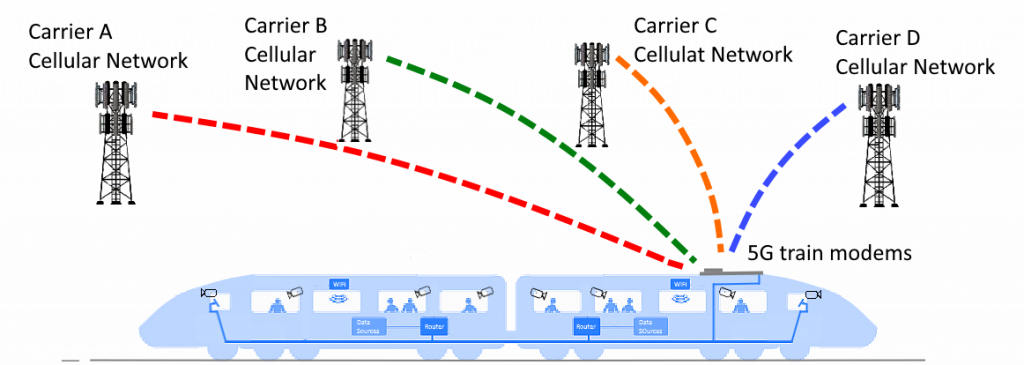
ELVA’s ARTICLE: Internet on trains: 5G or Trackside Network (TSN) — which will the market choose for Train-to-Ground?
The time between 2023 and 2025 could be the tipping point when major railroad operators choose between 5G mobile communications or building a dedicated proprietary Trackside Network (TSN) wireless network for wideband Train-to-Ground (T2G) connectivity.
Over the past few years, there has been a lot of hype around the prospect of using 5G for Train-to-Ground communications and providing passengers with broadband Internet access as they are used to in their homes, offices, or city streets.
Numerous predictions are being made about how 5G will solve the problems with broadband Internet access on trains. At the same time, railroad operators, not relying on cellular service, are launching projects of dedicated 5 to 94 GHz wireless TSN networks along the railroad tracks to meet the needs of the onboard online services.
Which technology is more promising for Internet access on trains: 5G or Trackside Network and which will the market choose?
What is the 5G throughput inside the trains today?
Can we say that where there is 5G coverage, the problem of broadband Internet access on trains has finally been solved and it’s just a matter of mass installation of new base stations and 5G-enabled smartphones? Yes and no – we’ll discuss that below.
In the U.S., the data speed numbers on the “Eastern Corridor” rail routes show that T-Mobile has the best results (compared to other operators), but 5G coverage is very patchy, and the example of train #449 shows that about half of the route simply has no connection.

Pros and cons of 5G for train-to-ground communications
The big pros of 5G are that it’s to be almost free for rail operators, and passengers don’t have to spend money on paid on-board Wi-Fi (to be fair, many rail operators provide it for free). To focus on 5G, the rail company doesn’t have to do anything at all – just wait for the mobile operators to install 5G base stations along the railroad tracks. Then they can do an inexpensive upgrade of the train modems that receive the signal from cellular towers from LTE to 5G and feed that traffic to the on-board Wi-Fi network.
The first weak point of this 5G train-ground strategy is: You’ll have to wait a long time for 5G coverage everywhere. Especially it’s true for long-distance rail routes and through non-populated areas. Mobile operators can count their money just as well as rail operators. Therefore, practice shows why 5G equipment along the railroad only appears on very popular and relatively short routes. For example, such as Boston to New York.
The second cons are that 5G inherits a common drawback of cellular communication in the form of a drop in bandwidth when a large number of subscribers are registered in a cell. The train carrying a few hundred passengers is an example of an event of such pump overcrowding of a cell.
As long as 5G-enabled smartphones are relatively uncommon, their owners can enjoy high-speed Internet connections on trains. But when all passengers will have such gadgets, the capacity of the base station channel will be expanded to all devices and the connection speed is expected to drop.
The third cons are the growing latency when registering a smartphone in the cell of the next base station as the train speeds up. Accordingly, the speed of connection to the Internet on the device will drop. Already for speeds of 100 km/h connection degradation will be about 30%. Compare these two videos in Helsinki, the video with the Speedtest measurement in the train and another video of the same blogger, made in the streets of Helsinki for the same mobile operator. You can see a clear difference. Yes, you can expect that for high-speed trains (250-400+ km/h) the quality of cellular communication will be even worse.
The fourth 5G train-ground disadvantage is the asymmetrical nature of 5G communication when the download speed of all operators is about 20 times higher than the upload speed. This disadvantage is especially difficult to eliminate in trains because of the physics of the process. And here’s why: The base station has a powerful transmitter, so the signal can be complexly modulated to provide a broadband connection. The smartphone’s transmitter, on the other hand, is low-powered, and in addition, operates from inside the metal body of the rail car. So, a simpler modulation scheme is forced (usually at the data rate for 4G to 3G) to allow the base station to receive a weak signal from the subscriber’s gadget.

These disadvantages are not critical on their own, but they have a negative synergistic effect. Today’s trains have a large number of digital systems, the most important of which is real-time video surveillance and online transmission of images from the driver’s cab and car cameras to the traffic control centre. This allows for AI facial recognition in order to prevent criminal and terrorist activity on trains, as well as to quickly respond to various alerts (fire, derailment, etc.).
The outage for remote video surveillance is unacceptable, and 5G’s outbound traffic (upload) capabilities are quite weak to transmit video streams from multiple HD cameras. Therefore, it is not surprising that rail operators are considering dedicated wireless network designs that do not depend on cellular coverage along the tracks and have symmetrical download/upload characteristics.
5G in Train-to-Ground Communication — How It Works
It is time to explain how the 5G signal from base stations along the tracks turns into onboard Wi-Fi for passengers. This is done using a special onboard router and rooftop 5G modems that are placed on the roof of the train. Below is a typical diagram for rail connectivity cellular technology with a wireless 5G modems.

Each 5G modem usually uses four SIM cards from different mobile carriers. This helps improve train-to-ground communications in case any carrier has poor cellular coverage on a given part of the track. The train uses several modems that are connected to a router, and the router sends the internet to the onboard Wi-Fi for the passengers.
The router can aggregate data from multiple modems, usually no more than three or four. This can result in total wireless train-to-earth throughput of up to several gigabits per train. Of course, this is under favorable conditions only. But in reality, passengers’ smartphones will compete for traffic, so the traffic is divided among all subscribers in the cell, including train modems and passengers’ smartphones. In addition, such peak throughput usually occurs only on short sections of the train route in urban areas.
Although 5G train modems can provide a train-to-ground connection of several gigabits (per download direction only), in reality this will be the case in some short track sections and not along the entire rail route. In addition, throughput in the upload direction will always be an order of magnitude lower.
Dedicated mm-Wave Trackside Network — How It Works
Now let to explain how the alternative to 5G works for train-ground communication. This is the installation of a dedicated wireless trackside network with broadband access to the carrier’s data center and then to the Internet.
The British regulatory body Ofcom recommends having a train-to-ground link of at least 1 Gigabit, preferably 2 to 3 Gigabits. With a millimeter-wave network, not only can these recommended values be achieved, but they can easily be surpassed.
Now about what dedicated carrier networks are. In terms of their architecture, they are almost identical for any equipment vendors, differing mainly in the frequency range and equipment characteristics in terms of radio design and communication capacity.

In general, the trackside network diagram is similar to the 5G train-ground architecture with the exception that there is only one operator and the wireless channel only works with the train equipment. Passengers’ gadgets cannot pick up the signal because it has a special frequency and modulation.
It should be added that usually mm-wave transceivers are installed forward and backward in the train, which avoids degradation of communication quality and obtains almost zero delay.
Summary for 5G for Train-Ground Connectivity
The launch of 5G cellular coverage zones along railroad tracks has breathed some hope into the possibility of broadband train-to-ground connectivity, both for powering onboard Wi-Fi traffic and for Internet access for individual passengers’ gadgets.
The launch by operators of 5G cellular coverage zones along railroad tracks has breathed some hope into the possibility of broadband train-to-ground connectivity, both for powering onboard Wi-Fi traffic and for Internet access for individual passengers’ gadgets.
The weakness of 5G connectivity for trains is low upload speeds, dependence on train speed, and lack of 5G coverage outside of densely populated areas. The low upload speed is crucial for remote video surveillance in trains.
An alternative of dedicated wireless networks (Trackside Network, TSN-network) along the railroad tracks for the needs of the rail operator is associated with large investments. Regulatory actions may play a certain role in stimulating the launch of TSN-network projects. For example, it could be in terms of mandatory orders for remote video surveillance in trains. Overall, the success of TSN-network projects will be influenced by the choice of technology, equipment vendors and, as a result, the unit cost of 1 km of railway equipment.
At the same time, the systems in the millimeter wave range look more promising for the construction of TSN networks along rail due to the availability of a large frequency spectrum and, consequently, the possibility of multi-gigabit connection “train-to-ground”, with the prospect of improving it to 40 – 100 Gbps.
If you want to know more about what the millimeter-wave radios are available to build a trackside network, visit ELVA’s PPC-10G-rail product page.
It is currently the best mm-wave E-band radios in the industry, allowing full duplex 10 Gbps train-ground throughput.
